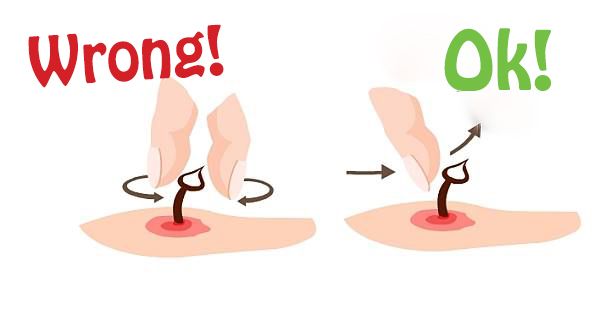Bee Sting - Power of Venom, How to Avoid, What to Do After

I invite you to another article about bees, this time maybe a less pleasant topic. In the article I will talk about stings, what to do after the sting, I compare the power of bee venom to wasp or hornet venom. In large part I will refer to my own experiences ; )
Feeling fear of stings is not foreign to beekeepers. Beekeepers, wanting to keep secret their activities, often spread the view that bees do not sting a person working in the apiary, because it is known to insects. This is of course a myth, because the bees' life during the season in summer is too short to recognize the beekeeper. The beekeeper knows how his bees behave, what he can do, how to behave. In this way, it effectively avoids stings, allowing you to work more than once without any security (which I personally think is extremely irresponsible).
Venom of a Honey Bee
Wasps or hornets use venom mainly to obtain food, attacking other insects. In the case of bees, the only use of venom is to scare off a potential attacker, usually large animals. Evolution of bee has created a poison that has much more power.
dose of venom
According to the LD50 value (lethal dose), it was determined that 10 to 90 mg of hornet venom per kilogram body weight was needed to kill mice. In the case of bees, it was already 6 mg / kg. According to the study, bee venom is 1.7 to 15 times stronger than hornet venom. What's more, during a single sting, the hornet is able to inject 0.01 mg of venom, while the bee from 0.05 to 0.14 mg. In the case of wasps, the venom dose is 20 times lower than in the bee. From my own experience, I can say that the pain is also incomparably smaller in the case of a wasp sting. Bee venom also contains alarm pheromones, which when released by one bee during the sting, mobilize others to sting.
sting construction

The sting construction also has a large impact on the sting. In the case of wasps or hornets, it allows you to pull the sting from the victim's body. In bees, burrs occurring on the sting, cause anchoring in the skin together with the entire venom tank. Muscle pumping venom, remain active for a long time after the sting, pumping venom from the reservoir. This is presented in the following video.
Health Risk
At the beginning it is worth noting that bees are not aggressive insects. Not provoked, they never attack people. As a rule, the bee sting causes little edema, sting, burning, which is not a major threat. The situation may be dangerous in the case of stings in sensitive areas such as the head, especially stings in the eyes and mouth are particularly dangerous. I can say from experience that in my case, people who do not have bee venom allergy, 3 stings in the head have ended up in a hospital visit and the need to give strong anti-allergic drugs in the form of a drip. The situation is even more dangerous in the case of people with allergies to bee venom. This is indicated by general symptoms such as rash, shortness of breath, dizziness, too high / low pulse. It is worth mentioning that the lack of allergies to wasp venom is not synonymous with the lack of allergies to bee venom! As a curiosity, I can add from myself that the most painful stings (at least for me) are around the knees: D
What to Do After the Sting
Above all, do not panic. At the beginning, you must remove the sting. It is very important how we will do it. If we do not do it correctly, we will inject all venom contained in the venom tank in an instant! The sting should be scratched. It's good to use a payment card for this. If we do not have anything similar at hand, let's do it with your fingernail. Moving it over the skin, we "slide" the sting. We do not catch the stinger in the fingers! This causes the poison container to squeeze and force the entire venom into the body!

In the case of people with allergies or if you notice general symptoms (shortness of breath, dizziness, rash or other), you should notify an ambulance. In this situation, the sting can cause a sudden allergic reaction and circulatory collapse (anaphylactic shock), which is a direct threat to life.

After the sting, the wound should be washed with vinegar, which to some extent neutralizes venom. It is also worth drinking lime (such as ordinary sparkling). I know from experience that lime helps, although many studies do not indicate it. I always drink 2 tablets after the sting.
How to prevent stings
1. Nie stawać i nie przechodzić na linii lotu pszczół - w szczególności dotyczy to przechodzenie przed ulami, wylatujące pszczoły przeważnie przez przypadek wlatują w człowieka, co przeważnie kończy się użądleniem. Należy przechodzić z tyłu uli, a nie przed ich wlotami.
2. Move slowly, do not make fast, sudden movements.
3. Do not approach the apiary in dark colors, wool or fleece clothes. Bees in the course of evolution have become sensitized to fur-like structures. It is not without reason that beekeeping cloth is light and smooth.
4. Bees also hate fragrances of perfumes, deodorants, sweat.
5. MOST IMPORTANT, do not enter the apiary without the proper attire, in particular the beekeeping hat.
Finally, I add that besides the danger bee venom carries a lot of pro-health activities ;)
It's all for today. See you soon!
@apismellifera
